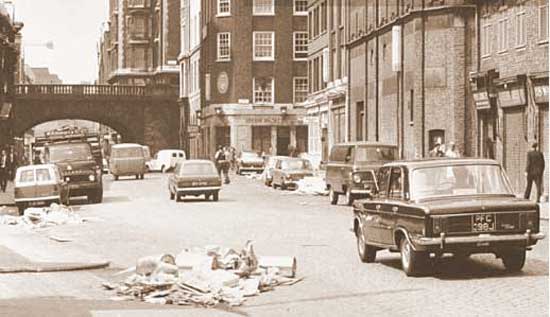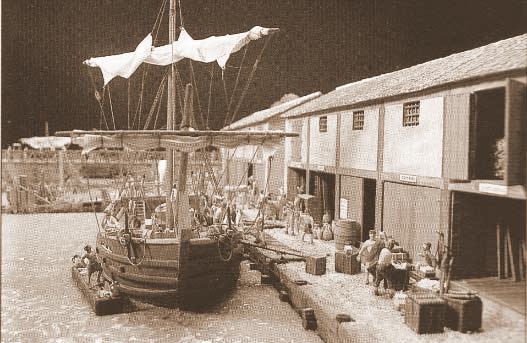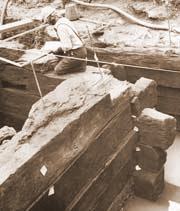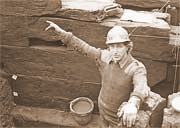Café on a Bridge PEN/PDN 1979-82
Gustav Milne
Once upon a time there was a café on a bridge. But it was not just any café, and it certainly wasn’t just any bridge. The cafeteria in question was Joe’s, 127 Lower Thames Street at the junction of Fish Street Hill in the City of London.
It played differing roles in a major multi-site multi-period archaeological project running from 1979-1982. The area spanned the insula from Botolph Lane to Pudding Lane, across to Fish Street Hill, and north to Monument Street, incorporating ten controlled area excavations and two extensive watching briefs.
Joe’s provided refreshments for the initial archaeological works to the east of Pudding Lane in 1979-80, then became a finds hut and HQ for the first phase of work west of that street in 1981. Later that year, after the café’s demolition, its basement actually became an archaeological excavation site in its own right, producing one of the City’s most important discoveries. The big surprise lurking under the basement floor was none other than Roman London Bridge, finally revealed to the world in November 1981 by a media whirlwind the like of which the DUA had never before experienced. Lower Thames Street 1970, looking W towards London Bridge, before demolition of buildings on N side of the street.
Lower Thames Street 1970, looking W towards London Bridge, before demolition of buildings on N side of the street.
Joe’s Café is at the corner of Fish Street Hill, with a Mini parked outside. The rubbish in the street from the Billingsgate early morning fish market was collected at lunch time.In the City in 1980, developer-funding for archaeology was still developing. There was serious money being spent on new building projects, and some developers were being persuaded to channel some of that into archaeological work in advance of redevelopments. But what was in it for them, given that there was then no statutory requirement to do so? Positive publicity was a major factor, but that depended on how much media interest might be generated by whatever it was that the archaeologists might chance to uncover: there were no guarantees provided in advance. That great archaeological maxim “expect the unexpected” cuts both ways.
Café Culture
The role that Joe’s Café played in this wider story was, to put it politely, somewhat unexpected. It was a hard-working café, serving Billingsgate Fish Market in the early morning, and City workers after that daily market closed. The archaeologists on the neighbouring Peninsular House site (PEN79) were very familiar with it. Tea was served from a large blue chipped enamel teapot with the milk already added: three or four mugs were filled in one controlled sweep of the spout. Coffee was also on offer: a large catering tin of Nescafe instant was standing by, and a heaped spoonful was rapidly discharged into the next mug, awaiting milk or sugar as requested.
The PEN79 archaeological site, on the eastern side of Pudding Lane, proved productive: a basement dramatically filled with debris from the Great Fire of London was excavated, as were Saxon buildings against Botolph Lane on the eastern side of the site. But even more unexpectedly, a well-preserved section of a 1st-century Roman quay constructed with massive oak timbers was uncovered on the site’s southern boundary, on the very northern edge of Lower Thames Street. This was over 150m north of the current course of the River Thames. As it happened, the buildings on the adjacent site to the west of Pudding Lane (included Joe’s Café) were also due for imminent redevelopment: that site’s archaeological potential was suddenly much enhanced.
Site for Sore Eyes
The proposed new archaeological excavations between Pudding Lane and Fish Street Hill were to be funded by the two developers, the English Property Company (EPC) and the National Provident Institution (NPI). The new investigations, coded PDN81, kicked off in January 1981 following demolition of the buildings on the eastern half of the site. The ground floor of what had been Joe’s Café the previous year now became the temporary site office and finds processing unit. The upper floors were closed off and condemned, awaiting the demolition squad. Following initial site clearance, the excavations soon revealed evidence of Roman buildings, a Roman waterfront warehouse and its associated timber-built quay. As work progressed, this well-preserved photogenic harbourside complex was gradually revealed, attracting genuine media interest. This was in addition to regular site tours for staff from the developers own City offices, attention from DUA site teams, Museum staff, academics, and from legendary London archaeologists Ralph Merrifield and even Professor Grimes, then aged 76. Recognition indeed for our spectacular Roman waterfront site.
Following initial site clearance, the excavations soon revealed evidence of Roman buildings, a Roman waterfront warehouse and its associated timber-built quay. As work progressed, this well-preserved photogenic harbourside complex was gradually revealed, attracting genuine media interest. This was in addition to regular site tours for staff from the developers own City offices, attention from DUA site teams, Museum staff, academics, and from legendary London archaeologists Ralph Merrifield and even Professor Grimes, then aged 76. Recognition indeed for our spectacular Roman waterfront site.
All in all the archaeological team were happy with the results of their hard work, conducted in, shall we say, somewhat changeable weather. The Polyspan shelters that allegedly protected the delicate archaeological remains were tested to  destruction (literally) by some torrential downpours. But whenever climate change proved a little too negative for some, the uplifting strains of Nic Bateman’s rendition of “Whats the matter you It’s a nice a place Shuddup your face” (a popular song of the period) rang round the site, rapidly raising morale. Another problem to contend with was the active demolition of the buildings up against Fish Street Hill and the resultant removal of dusty brick debris in convoys of lorries.
destruction (literally) by some torrential downpours. But whenever climate change proved a little too negative for some, the uplifting strains of Nic Bateman’s rendition of “Whats the matter you It’s a nice a place Shuddup your face” (a popular song of the period) rang round the site, rapidly raising morale. Another problem to contend with was the active demolition of the buildings up against Fish Street Hill and the resultant removal of dusty brick debris in convoys of lorries.
In its depths what treasures
Anyway, once Joe’s café in the extreme SW corner of the site had been removed by 10th July the team wondered what else could turn up that hadn’t already been recorded? It took a while to clear the new site (labelled Area F), lay out a grid that related to the grids for the other trenches (A, B and C) and start excavating. Certainly we expected the Roman quay would continue to run across the new trench supervised by Jez Reeve. By 27th July the top of the timber-built quay was already partially exposed, but first the remains of overlying  buildings and thick dumps of fire debris had to be fully excavated. Luckily, the weather improved and work progressed steadily. As Chrissie recalls, flares had long since been replaced by straights while, for some, wellington boots were swapped for jelly sandals, weather permitting. But most of the team took the afternoon off on 29th July, since there was a Royal wedding at St Paul’s. Cleary, Punk’s “Anarchy in the UK” had finally been replaced by the New Romantics.
buildings and thick dumps of fire debris had to be fully excavated. Luckily, the weather improved and work progressed steadily. As Chrissie recalls, flares had long since been replaced by straights while, for some, wellington boots were swapped for jelly sandals, weather permitting. But most of the team took the afternoon off on 29th July, since there was a Royal wedding at St Paul’s. Cleary, Punk’s “Anarchy in the UK” had finally been replaced by the New Romantics.
Perhaps of more significance for popular culture, and for archaeology in general, was the release of the first Indiana Jones movie, which Spielberg kindly timed to coincide with the increasing excitement building up in Lower Thames Street. As more of the quay was exposed, it was soon obvious that, instead of running directly into the western limit of excavation, the Fish Street Hill frontage, it decided to stop and change direction, heading north for a while. This created an intriguing inlet that clearly would require special attention. By the end of September, all the deposits and structural features  overlying the quay had been recorded, and a sections cut through the infills, revealing two structural phases of the 1st century quay. Work had also begun on excavating the fills to the south (riverwards) side of the quay, which revealed more timberwork, hard up against the southern limit of excavation. Excavation continued, often in rather confined spaces and in spite of poor weather, requiring shelters to be erected to protect at least part of the site.
overlying the quay had been recorded, and a sections cut through the infills, revealing two structural phases of the 1st century quay. Work had also begun on excavating the fills to the south (riverwards) side of the quay, which revealed more timberwork, hard up against the southern limit of excavation. Excavation continued, often in rather confined spaces and in spite of poor weather, requiring shelters to be erected to protect at least part of the site.
By the end of October, enough of the deep dumped deposits had been removed, and the timber structures revealed were carefully recorded to expose the structural sequence. Contrary to first impressions it was now clear that the most southerly partially-revealed timber box structure was not a later addition to the quay, but had been built free-standing on the foreshore in what was, in the first century AD, the River Thames. Indeed, some of the lowest members of the free-standing feature had actually been deliberately cut through when the main 1st-century quay structure was extended westwards. In other words, our upstanding pier must have already been in place and in operation before that date. One interpretation presented itself above all others. Might it actually be part of the first Roman London Bridge?
Storm in a Tea Cup
And so it was: the secret in the cellar of Joe’s Café was out. The explosion was expected, but the intensity was, shall we say, underestimated. Not having mobile phones in those days, messages from the hard pressed Press Office simply appeared on site to say who wanted an interview when, and who wanted to film you (or rather it). There was the Telegraph, the Financial Times, City Recorder, Baltimore Echo, a Japanese paper, as well as Thames TV, ITN News, BBC Newsnight, World at One, LBC, Radio London and BBC External Services, to name but some. Then there were visits from the developers, as well as eg Professor Wilkes, Professor Wacher and Richard Reece, the Science Museum, the GLC, sundry colleagues and friends from the DUA and the Director of the MoL, Max Hebditch himself. The site entrance had to be secured to allow public viewing (but not public access) and further preparations made for public viewing on the upcoming Saturday, that being the Lord Mayor’s Show.
Unfortunately, the Museum had previously been working hard prepping features on the MoL’s float for the show, promoting “London’s Flying Start”, the story of London’s role in early 20th-century aviation. Alas, all the spaces they had been promised across the media were cut overnight and replaced with the Roman London Bridge story. I’m not sure if the Museum’s Modern Department ever forgave the archaeologists for that.
But at least the developers, NPI and EPC, had seen a real return for their money: a full decade before the formal introduction of Planning Policy Guidance Note 16 (look it up), archaeologists proved that they could indeed generate positive stories.
 And the media feeding frenzy continued unabated: I was collected by a taxi straight from site, boots and all, and driven to the BBC’s Nationwide offices at Lime Grove for another live interview, this time in a clean studio. This I had to deliver while wearing my old site jumper which unfortunately had some holes in it, lovingly filmed by Camera Two.
And the media feeding frenzy continued unabated: I was collected by a taxi straight from site, boots and all, and driven to the BBC’s Nationwide offices at Lime Grove for another live interview, this time in a clean studio. This I had to deliver while wearing my old site jumper which unfortunately had some holes in it, lovingly filmed by Camera Two.
Five minutes later I was back in the taxi being driven across London to the Westbourne Council Estate in Holloway. I stopped the cab two streets away from my flat, as riding in taxis was not the done thing there. So finally home, and very much back down to earth. After all, the cats were furious, demanding to know why the dinner was so late. I couldn’t excuse my behaviour by blaming the media, as I didn’t have a TV for them to watch anyway.
 Cleaning the bridge pier in preparation for its photographic record by Jon BaileyAs for Joe, we wondered what he would have thought about the goings on below his basement. It has been said that in England, a cup of tea is the answer to every problem: in this case, even an archaeological one.
Cleaning the bridge pier in preparation for its photographic record by Jon BaileyAs for Joe, we wondered what he would have thought about the goings on below his basement. It has been said that in England, a cup of tea is the answer to every problem: in this case, even an archaeological one.
With many thanks to the team which included, to name but a few, Nic Bateman, David Bowler, Mark Burch, Peter Cardiff, Prince Chitwood, Phillip Claris, Barbara Davies, Sarah Dilane, Chris Guy, Chrissie Harrison, Val Horsman, Wendy Horton, Pete James, Patrick Newell, Jez Reeve, Caroline Rochester, Sandra Rose, Alison Taylor, Kirsten Taylor and Pip Thompson’s dedicated CoLAS weekenders.



Comments powered by CComment